How to read chords and sheet music without stress
I show simple steps to start with music notation and read the staff. I map notes on the treble and bass clefs, learn rhythm and rests, and read chord symbols and lead sheets. I share hands‑on drills for note memory, chord building from intervals, two‑hand piano reading, and a short daily sight‑reading routine. I keep it calm, practical, and doable so you can practice without overwhelm — a clear path for anyone wanting to learn How to read chords and sheet music without stress.
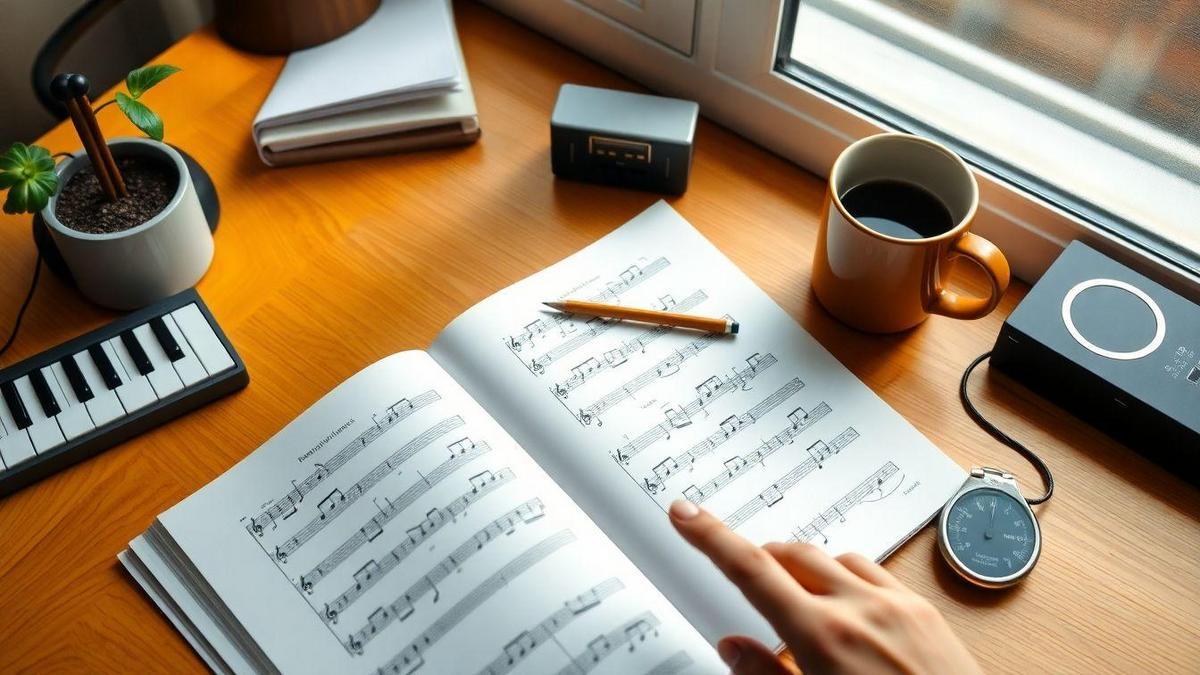
Key takeaway
- Read chord symbols above the staff and play them.
- Learn note names to read the melody on the staff.
- Match chord symbols to shapes on your instrument.
- Count beats and tap time to keep a steady rhythm.
- Slow down tricky parts and practice them slowly.
How I start with music notation for beginners
How I read the staff: lines and spaces
The staff has five lines and four spaces. Each line and space is a note. Start with the clef: the treble clef (G clef) points to G on the second line; the bass clef (F clef) marks F on the fourth line. Saying the clef out loud is a tiny habit that anchors you. For a concise reference, see Overview of Western musical notation basics.
Treble and bass quick reference:
| Clef | Lines (bottom → top) | Spaces (bottom → top) |
|---|---|---|
| Treble | E G B D F | F A C E |
| Bass | G B D F A | A C E G |
Keep this table visible near your instrument. Check the clef, scan the line or space, and say the note name before you play it. If you’re deciding between instruments as you learn these basics, a short guide on choosing your first instrument can help you pick an approach that fits your goals: how to choose your first instrument without regrets.
How I memorize note names on the staff
Three quick, portable tricks:
- Use mnemonics (short, silly phrases stick).
- Link notes to your instrument (find Middle C on piano; map a guitar string).
- Use quick flashcards (2 minutes at a time—fast reps win).
Example mnemonics:
| Clef | Lines mnemonic | Spaces mnemonic |
|---|---|---|
| Treble | Every Girl Buys Donuts First | FACE |
| Bass | Good Boys Do Fine Always | All Cows Eat Grass |
If you’re wondering whether music theory is intimidating, remember there are practical, bite‑sized ways to approach it — theory becomes useful when applied to real songs: why music theory doesn’t have to be scary.
Hands‑on note reading drill
Do this at the instrument:
- Set timer for 5 minutes. Short bursts.
- Pick the clef and say it out loud.
- Read one measure slowly; name each note before playing.
- Play with a metronome at a slow tempo.
- Add one new measure the next day.
Track progress with a sticky note. Small, repeated wins build confidence. For a simple daily format that keeps things consistent, try a compact practice structure designed for busy schedules: simple practice routines you can do daily.
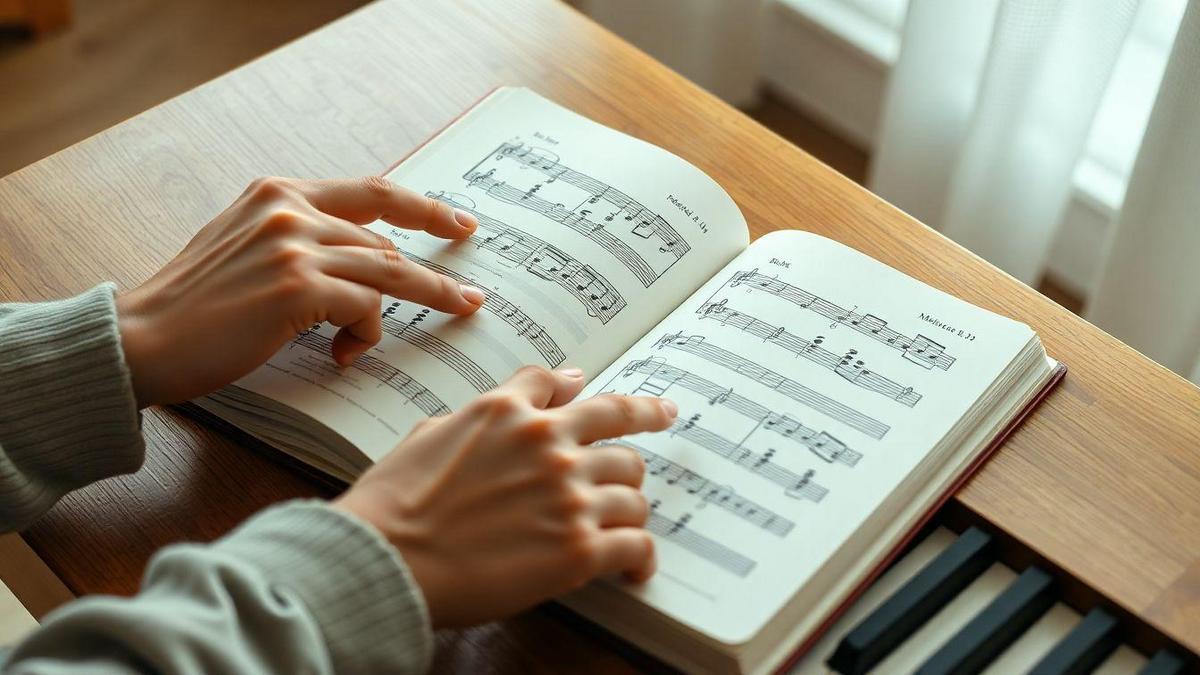
How I read clefs: practical mapping
How I map notes in the treble clef
Spot the treble clef (the big swirl) — the swirl points to G above middle C (my G anchor).
Rules:
- Lines = E G B D F (Every Good Bird Does Fly)
- Spaces = F A C E (FACE)
On piano, find Middle C and count up; on guitar, match to a fret; on voice, sing to a piano note.
Quick practice reference:
| Staff place | Note (treble) | Quick tip |
|---|---|---|
| Line 1 (bottom) | E4 | Right hand thumb on piano |
| Space 1 | F4 | Think FACE |
| Line 3 (middle) | B4 | Landmark |
| Line 5 (top) | F5 | High melody note |
Practice aloud: point, name, play — repeat five notes in a row.
How I map notes in the bass clef
Find the bass clef (dots hug the F line — my F anchor).
Rules:
- Lines = G B D F A (Good Boys Do Fine Always)
- Spaces = A C E G (All Cows Eat Grass)
Map to left hand or low strings.
Quick practice reference:
| Staff place | Note (bass) | Quick tip |
|---|---|---|
| Line 1 (bottom) | G2 | Low piano key / open low string |
| Space 1 | A2 | Left hand second finger |
| Line 3 (middle) | D3 | Chord root reference |
| Line 5 (top) | A3 | Near middle C area |
If you’re comparing how guitar and keyboard approaches differ for reading, these side‑by‑side perspectives make the mapping clearer: guitar, keyboard or drums — which one fits your style? Clef labeling trick: write bold letters above the staff on page one, colored dots for lines/spaces, then remove after a few practices.
Rhythm: counting and rests
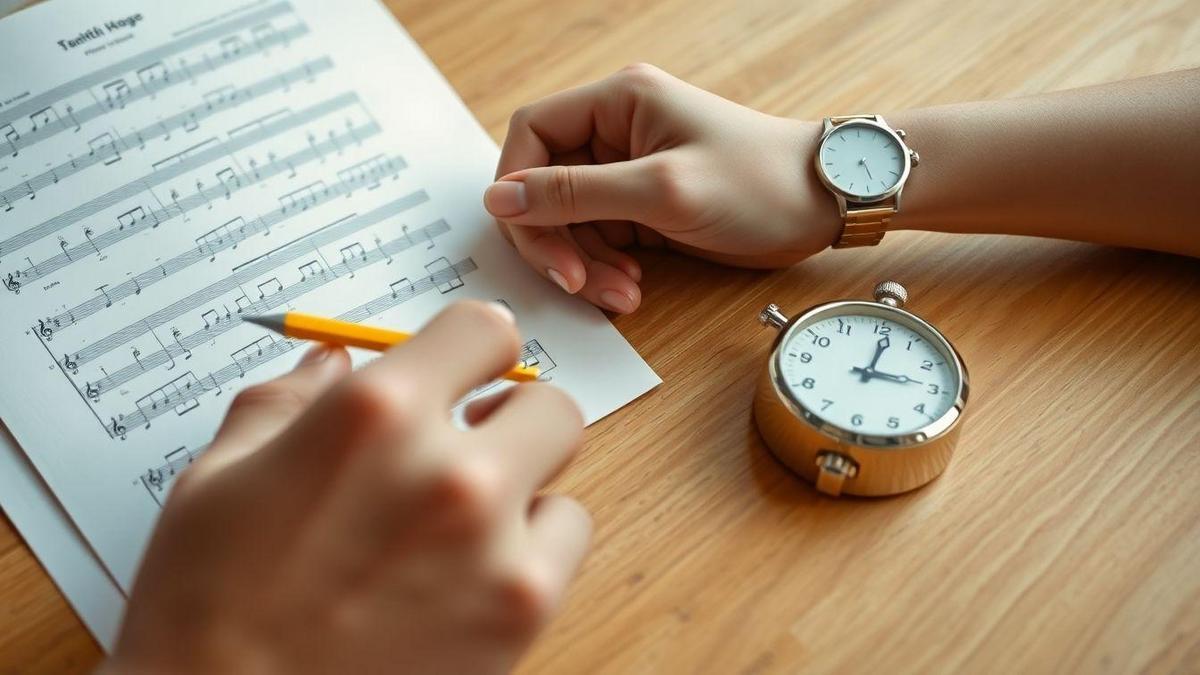
Note values (4/4)
Visualize a whole pie and subdivide:
| Note | Symbol | Beats (4/4) | How I count it aloud |
|---|---|---|---|
| Whole | ○ | 4 | “1-2-3-4” (hold) |
| Half | 𝅗𝅥 | 2 | “1-2” (hold) |
| Quarter | ♩ | 1 | “1” |
| Eighth | ♪ | 1/2 | “1 &” |
| Sixteenth | ♬ | 1/4 | “1 e & a” |
Tap foot on quarters; say “&” for eighths; say “e” and “a” for sixteenths. Slow practice and clapping help internalize these. See Open Music Theory rhythm and meter chapter for exercises and explanations.
Rests
Rests are silent counts — count them out loud exactly as you would play notes:
| Rest | Beats | How I count it |
|---|---|---|
| Whole rest | 4 | “1-2-3-4” (silent) |
| Half rest | 2 | “1-2” (silent) |
| Quarter rest | 1 | “1” (silent) |
| Eighth rest | 1/2 | “1 &” (silence on “&”) |
| Sixteenth rest | 1/4 | “1 e & a” (silence on parts) |
Use a metronome as anchor. Call every subdivision when a mix of notes and rests appears.
Basic rhythm clapping drill
- Metronome 60 BPM; tap foot.
- Clap quarters for 4 bars, count “1,2,3,4”.
- Clap eighths for 4 bars, say “1 & 2 &…”.
- Clap sixteenths for 2 bars, say “1 e & a”.
- Mix values and add rests; speed up by 5 BPM when steady.
Ten minutes a day tightens timing. If you only have a short window, the idea of focused daily blocks — even just twenty minutes — can be surprisingly effective: the power of just twenty minutes daily.
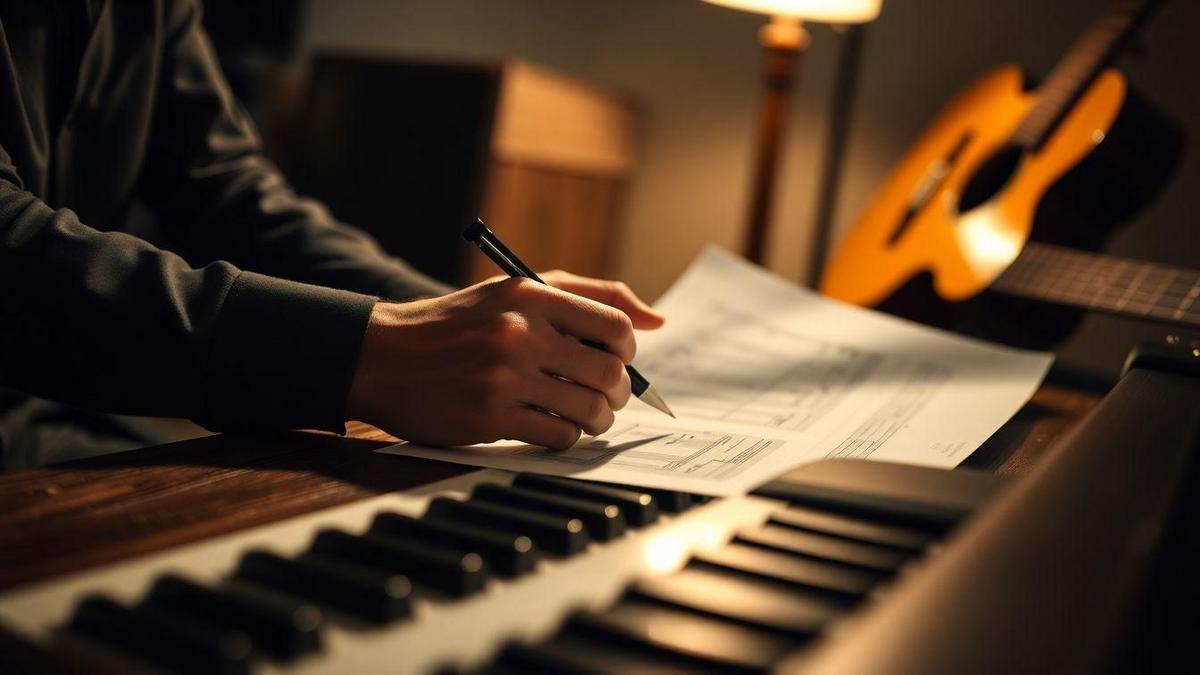
How I read chords and charts on lead sheets
How I read chord symbols
Read the root first, then the quality (major, minor, 7, maj7), then extensions/alterations (9, 11, b5, #11). For slashes (C/G), play the left as chord and right as bass.
| Symbol | What I play | Why it matters |
|---|---|---|
| C | C–E–G | Basic major |
| Am | A–C–E | Minor |
| G7 | G–B–D–F | Tension → resolution |
| Cmaj7 | C–E–G–B | Softer, jazzy |
| Dm7/G | Dm7 with G bass | Changes low color |
Quick tips:
- Short symbols → basic triad.
- Numbers → add tones gradually.
- Unsure? Play root third first.
If chord names feel like a lot at first, remember that understanding intervals and stacking thirds is the practical side of theory — you can get comfortable quickly with guided, small steps: practical music theory for playing and songwriting. The Practical guide to reading lead sheets from Berklee explains conventions and how to translate symbols into playable voicings.
Follow melody with chord changes
Listen to the melody on strong beats; match voicings so the melody note is a prominent chord tone (3rd or 7th). If melody is non‑chord tone, choose lighter voicings.
Example: melody E over C → play C (C–E–G). Melody D over C → try Cmaj9 (C–E–G–D).
Lead sheet practice routine
Short blocks with clear focus:
| Block | Time | Focus |
|---|---|---|
| Warm‑up | 5 min | Scales, single‑note melody |
| Read‑through | 10 min | Lead sheet with simple chords |
| Melody focus | 10 min | Melody with chord tones |
| Color & voicings | 10 min | Add 7ths, 9ths, suspensions |
| Performance run | 5 min | Play full tune at tempo |
Steps: scan key/repeats, play melody alone, add basic chords on downbeats, match chord tones to strong melody notes, record and listen back. For a clear daily structure to support these blocks, see a simple routine you can adapt to any schedule: create a simple practice routine.
Chord diagrams for guitar and piano
I use chord symbols and diagrams like a quick map — this is essential if you want to learn How to read chords and sheet music without stress. Focus on root, quality, and one reliable voicing per instrument.
Guitar chord chart checklist
Read the chart one beat at a time:
| Step | What I look for | Quick tip |
|---|---|---|
| 1 | Chord symbol (C, G7, Am) | Say it out loud |
| 2 | Diagram (strings = vertical, frets = horizontal) | Top row = nut |
| 3 | Find the root | Use low string if shown |
| 4 | Finger numbers | Place slowly at first |
| 5 | X or O | X = mute, O = open |
| 6 | Barre marks | Curve = barre |
| 7 | Strum pattern | Tap rhythm with foot |
| 8 | Transition notes | Use as guides for next chord |
Say the steps aloud to cut lookup time. If you’re deciding whether to focus on guitar or keyboard shapes, this comparison helps you weigh the pros of each: guitar vs keyboard — quick comparison.
Piano voicings and inversions
Choose a clear triad or seventh that supports the melody; use inversions to smooth bass lines.
| Symbol | Basic notes | Common inversion |
|---|---|---|
| C | C E G | 1st inv: E G C |
| Am | A C E | 1st inv: C E A |
| G7 | G B D F | 2nd inv: D F G B |
| F | F A C | root or 2nd inv |
Steps: read symbol → pick voicing → choose inversion → play slowly and listen.
Quick chord reference (keep handy):
| Symbol | Guitar (simple) | Piano voicing |
|---|---|---|
| C | x32010 | C–E–G or E–G–C |
| G | 320003 | G–B–D or B–D–G |
| Am | x02210 | A–C–E or C–E–A |
| F | 133211 | F–A–C or C–F–A |
| D | xx0232 | D–F#–A or F#–A–D |
If you want a broader set of perspectives on which instrument suits your learning style, these quick reads are useful: instrument fit — take 3 and more on choosing guitar or keyboard.

How I build chords from intervals — fast and practical
I use intervals as building blocks. Name the root, then add the third, fifth, and the seventh if needed. This helps you read and play chords quickly — a core part of How to read chords and sheet music without stress.
Spot major and minor intervals
Count semitones:
- Minor 3rd = 3 semitones (sad)
- Major 3rd = 4 semitones (bright)
- Perfect intervals (4th, 5th, octave) = stable anchors
Interval quick reference:
| Interval | Semitones | Feeling |
|---|---|---|
| Minor 2nd | 1 | tense |
| Major 2nd | 2 | step |
| Minor 3rd | 3 | sad |
| Major 3rd | 4 | bright |
| P4 | 5 | open |
| Tritone | 6 | unstable |
| P5 | 7 | strong |
| Minor 7th | 10 | bluesy |
| Major 7th | 11 | dreamy |
| Octave | 12 | same, higher |
Sing root then the interval to train your ear. Breaking chord names into intervals removes mystery — this is the practical side of theory: music theory made practical for players.
Form triads and sevenths
Stack thirds:
- Major triad = root major 3rd perfect 5th (C–E–G)
- Minor triad = root minor 3rd perfect 5th (C–Eb–G)
- Diminished = root minor 3rd dim 5th (C–Eb–Gb)
- Augmented = root major 3rd aug 5th (C–E–G#)
Sevenths add another third on top (Major7, Dominant7, Minor7, etc.). Break chord names into intervals and find notes on your instrument.
Interval stacking exercise (5 minutes daily): pick root, add major/minor 3rd, stack to triad, add 10/11 semitones for minor7/major7, repeat in a few keys, sing before you play. If you’re wondering whether steady practice or talent matters more as you build these skills, the evidence favors consistent practice: talent vs practice — why practice wins.
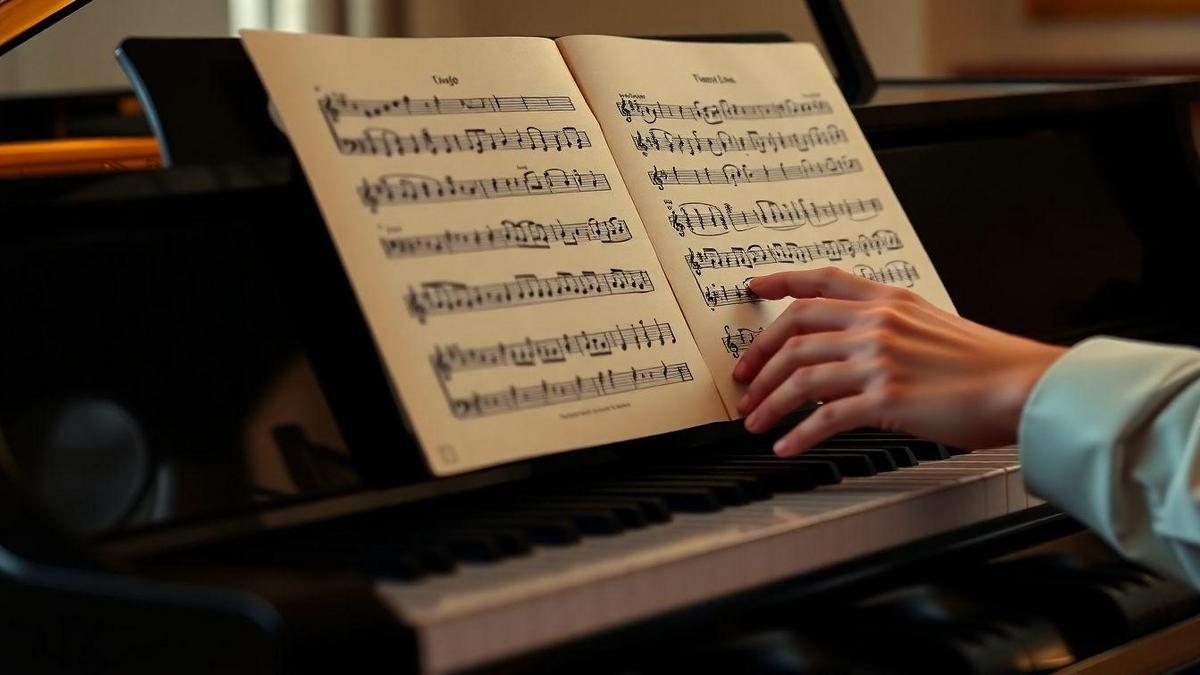
How I read piano music on the grand staff for both hands
See the grand staff as two teams: treble (right hand) and bass (left hand). Middle C sits between them — your anchor. Mark Middle C on the paper and map notes to keys; say note names as you point.
| Staff part | Cues | Quick action |
|---|---|---|
| Treble clef | stems up, melody | Play with right hand, sing if needed |
| Bass clef | stems down, lower notes | Play with left hand, feel groove |
| Middle C / ledger lines | ledger line between staves | Place thumb on Middle C, bridge hands |
Match left and right hand parts
Find the pulse and shared rhythms. Steps:
- Clap left hand rhythm.
- Clap right hand rhythm.
- Count aloud while doing each hand.
- Play both hands on one chord to lock timing.
Simplify first, then add detail. Slow joining fixes alignment issues.
Spot common chord shapes on the staff
Chords are vertical stacks (root, third, fifth):
- Stacked thirds = triad
- Three notes close = root position
- One note below two = first inversion
- One note above two = second inversion
Name the root quickly and place your hand.
Two‑hand slow practice:
| Round | What I do | Time |
|---|---|---|
| 1 | Right hand only | 2–3 min |
| 2 | Left hand only | 2–3 min |
| 3 | Hands together at half speed | 3–5 min |
| 4 | Hands at tempo, add dynamics | 2–3 min |
Repeat tripped bars slowly three times, then return to the full line. If you’re still deciding whether to focus on keyboard techniques or learn both keyboard and guitar shapes, this comparison may help you plan next steps: keyboard vs guitar — next steps.

How I use chord progressions to play and write
I–V–vi–IV: a practical progression
Hear the shape and pick a key you can sing in. Play slowly and listen for the hook.
I–V–vi–IV examples:
| Key | I | V | vi | IV |
|---|---|---|---|---|
| C major | C | G | Am | F |
| G major | G | D | Em | C |
| D major | D | A | Bm | G |
Practice with steady rhythm, try inversions to smooth motion, and sing short phrases over changes. Memorizing a few progressions like I–V–vi–IV helps you read charts and chord symbols faster — essential to learn How to read chords and sheet music without stress.
Transpose for jams
Shift chords by the same interval or use a capo on guitar.
Example: C–G–Am–F → transpose to G → G–D–Em–C.
Steps: find current I → count interval → move every chord the same amount → use capo if shapes get hard.
Song sketch from one progression
Set tempo (e.g., 88 BPM), play simple hits on beats 1 and 3, and let the progression guide melody and harmony. Small arrangements turn sketches into full sections fast.

Sight‑reading and reducing stress — a calm approach
Breathe, look for patterns, and treat the page like a map. If you feel tense, stop, breathe, and play one easy line. Focus on chords, rhythm, and small shapes first, then add speed. For structured sight-reading practice and tips, see ABRSM sight-reading and practice resources.
Playing regularly also helps your mind — music can be a clearing, stress‑reducing activity when approached calmly: music as therapy and stress relief.
Daily habits for steady progress
Make practice tiny and regular. Short sessions every day beat long, rare practices.
- Goal: 5 minutes of sight‑reading daily.
- Track progress and reward consistency.
Mini plan:
| Time | Activity | Purpose |
|---|---|---|
| 5 min | Sight‑read new piece | Build fluency |
| 10 min | Work problem bars | Fix trouble spots |
| 5 min | Play a favorite tune | Stay motivated |
If you miss a day, do one minute the next day — keep momentum. For practical templates and timing ideas that fit life, check a few approachable routines: simple daily practice formats and the idea behind focused short sessions: why short, focused practice works.
Chunking: slow down to learn fast
Break music into bite‑sized chunks:
- One beat: clap rhythm, sing pitches.
- One measure: hands separately.
- Two measures: connect and repeat.
Five‑minute daily sight‑read routine (coffee break friendly):
| Minute | Task |
|---|---|
| 0:00–0:30 | Scan: key signature, time, chord symbols |
| 0:30–1:30 | Clap or tap the rhythm aloud |
| 1:30–3:00 | Play slowly at half speed (one hand) |
| 3:00–4:30 | Add the other hand, keep it slow |
| 4:30–5:00 | Play once at comfortable speed, smile |
If you trip, note the bar and move on. Return later with calm energy. If doubts about progress arise, remember that steady practice beats waiting for talent — and everyone can make steady gains: why practice matters more than raw talent.
Quick checklist: How to read chords and sheet music without stress (fast summary)
- Scan the page first: key, clef, time, chord symbols.
- Label the clef and a few notes if needed; remove labels after a couple of practices.
- Map notes to your instrument (find Middle C on piano or reference string/fret on guitar).
- Count beats and speak subdivisions aloud. Use a metronome.
- Read chord symbols: root → quality → extensions → bass. Start with root third if unsure.
- Stack intervals to build chords; practice interval singing.
- Chunk difficult passages; simplify rhythms and notes, then add detail.
- Practice tiny and often: five minutes daily scales, five minutes sight‑reading.
- Breathe, smile, and treat sheet music like a map — repeatable moves make reading reliable.
For more on creating a focused routine and staying consistent, see resources on practice structure and short session strategies: simple practice routines and the value of focused short sessions.
Conclusion
Keep it simple and practical: scan the page, map notes to your instrument, count the beats, and play slowly until it feels steady. Small habits win: label the clef, use mnemonics for note names, anchor timing with a metronome, and match melody notes to chord voicings. Stack intervals to build chords and practice shapes until they’re second nature. Chunk difficult sections, add detail later, and practice short daily drills.
Practice these steps and reading becomes calm, useful, and even enjoyable. Follow this plan and you’ll see how to read chords and sheet music without stress. For more hands‑on tips, visit https://clickneutro.com.
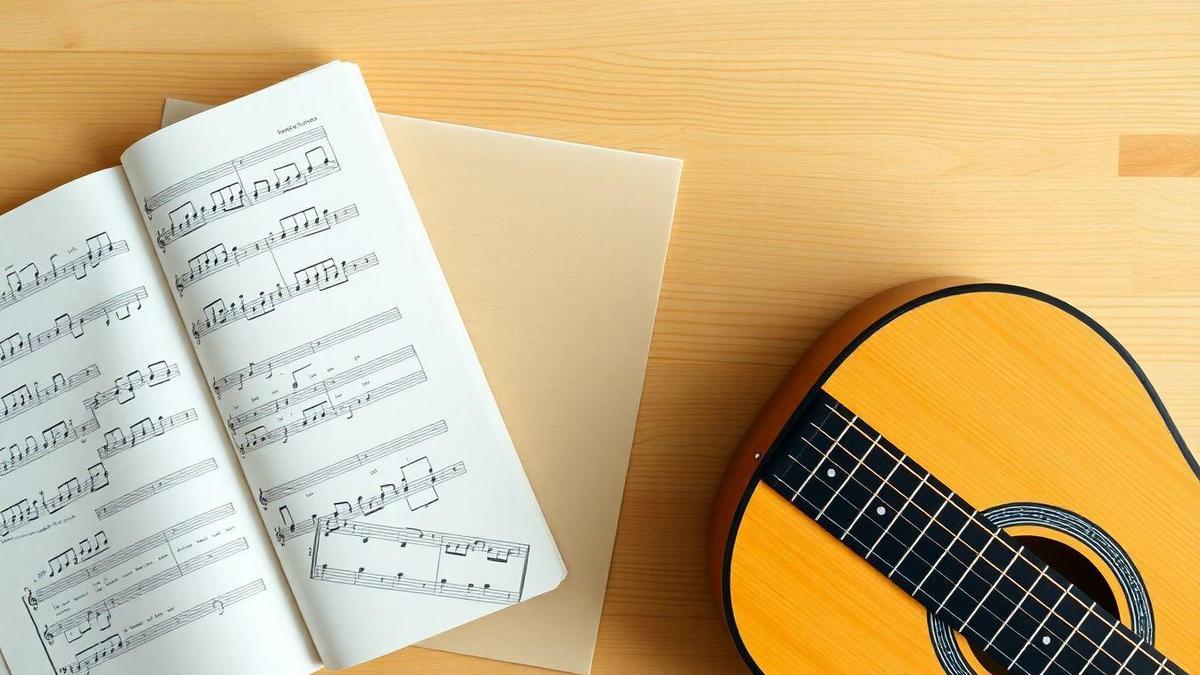
1 comentário em “How to read chords and sheet music”